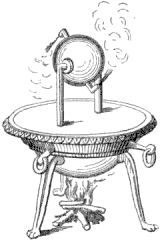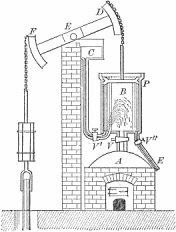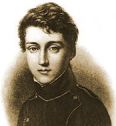Steam Engines and the Fate of the Universe

(2004-02-15) The Aeolipile
Great ball of wind and fire.

The first documented steam engine was merely a toy.
It consisted of a boiler whose outgoing steam was routed through hollow supports
into a spherical chamber, which rotated on a polar axis when steam escaped from two
jet tubes (tangential to its equator).
This is described,
with many other pneumatic or hydraulic devices,
in Spiritalia seu Pneumatica (c.60 AD)
by the mathematician Hero of Alexandria.
The term aeolipile
(French éolipyle, Latin
Aeoli pylae, "ball of Aeolus")
may have been coined in the 17th century, when other steam engines
first appeared.
Hero himself said he invented only a fraction of what he described...
The aeolipile may have been one of many ingenious contraptions
due to a prolific inventor by the name of Cestesibus.
The Pneumatics of
Hero of Alexandria, translated (1851) from the original Greek
(2005-06-26) Edward Somerset
of Worcester (c.1601-1667)
A blueprint for a steam-powered fountain (1662).
Edward Somerset was known as Lord Herbert after 1628.
In 1644, he became earl of Glamorgan, before inheriting the
title of sixth earl and second marquis of Worcester, in 1646.
Worcester published his design but apparently never built
an actual steam engine.
He proposed using the partial vacuum created when steam condenses
to obtain mechanical work from atmospheric pressure.
This was the key idea used by Newcomen in
his successful atmospheric engine, half a century later.
(2004-02-15) Denis Papin (1647-1714)
Beyond the pressure cooker: The first actual piston engine (1690).
The Frenchman Denis Papin invented the pressure cooker
A pressure cooker is a heated closed container.
Food cooks faster in it because the temperature of water can be
higher than the boiling point under ordinary atmospheric pressure.
A critical feature of the pressure cooker is, of course, its safety valve.
In 1690, Papin had the idea of fitting a piston over a boiler
with a limited amount of water in it.
When the boiler is heated, water becomes steam and the piston is
pushed upward.
When the boiler is allowed to cool, the steam condenses and atmospheric
pressure pushes the piston down, back to the original volume.
Although considerable forces can be involved, the power of Papin's engine is
low, because the heating and cooling of a single chamber is a
slow process.
(2005-06-25) Thomas Savery
(c.1650-1715): Separate Boiler
The Miner's Friend, Savery's two-piston steam engine (1698).
The English engineer Thomas Savery built an engine consisting
of two pistons over copper vessels which were alternately fed with steam
from a separate boiler.
This high-pressure engine could raise water about 20 feet (6 m).
Thomas Savery obtained several patents before
Thomas Newcomen made his own entrance.
(At some point, Savery may have employed Newcomen,
whose blacksmith shop was only
15 miles away from Savery's residence at Modbury.)
(2005-06-30) John Theophile Desaguliers
(1683-1744)
.../...

(2005-06-25) Thomas Newcomen (1663-1729):
Inner Cooling
Newcomen's atmospheric steam engine (1712).
Thomas Newcomen was an English blacksmith born in Dartmouth (Devonshire)
who set up shop there in 1685,
in partnership with a plumber named John Calley
[also spelled "Cawley"] (d.1717) who shared his interest in engines.
In 1698, Newcomen started corresponding with
Thomas Savery
and attempted to improve on Savery's machine to produce a safe and
reliable steam engine.

In 1708, Newcomen obtained a patent
(jointly with Savery)
for what's usually considered to be the
first practical
steam engine.
The use of low-pressure steam (5 psi) made it extremely safe.
The key idea was to spray cold water inside the piston's
chamber when is was filled with steam.
This caused steam to condense rapidly, and
the atmosphere pushed the piston back to a smaller volume.
In 1712, the first operational engine was built over
a mine near Dudley Castle.
It ran at 6 to 8 strokes per minute, with manual valves.
Automatic valves later allowed a typical regime of
10 to 12 rpm.
Newcomen's engine was successfully used to pump water from coal mines
throughout Europe. It was even exported to North America in 1755.
 (2005-07-06) Nicolas Joseph Cugnot (1725-1804)
(2005-07-06) Nicolas Joseph Cugnot (1725-1804)
Le
Fardier de Cugnot was the first automobile (October 1769).
Joseph Cugnot was a French military engineer.
Ostensibly, he designed his fardier à vapeur
(steam dray) for the purpose of hauling artillery pieces.
The second prototype, which was completed by June 1771,
is religiously preserved in Paris, at the
Conservatoire National des Arts et Métiers.
 (2004-02-15) James E. Watt (1736-1819)
(2004-02-15) James E. Watt (1736-1819)
The steam engine comes of age: Steam condenser
and governor.
The water-cooled steam condenser, patented by James Watt in 1769,
was the key to a dramatic improvement in the efficiency of steam engines.
Although the fundamental issue was not fully understood until 1824
(see Carnot's limit below)
this improved efficiency came from a greater temperature difference
[or ratio, rather] between active parts of the engine
throughout its cycle.
Watt's engine has two separate chambers:
The piston's cylinder remains at the temperature of
hot steam, while the steam condenser is water-cooled.
Among many other innovations,
Watt also introduced an ingenious speed regulator in 1788,
which is probably the earliest technological example of a
feedback mechanism:
The so-called Watt governor
(also known as the centrifugal or flyball governor)
made steam engines safer and easier to use.
By 1790, the new and improved Watt engines
had all but completely replaced Newcomen engines.
Watt's clever innovations were so successfull that it's now
necessary to stress that James Watt
did not invent the steam engine!
(2005-06-26) Richard Trevithick (1771-1833):
Steam Locomotive
The inventor of the railroad locomotive was not George Stephenson.
In 1796, Richard
Trevithick experimented with high-pressure noncondensing
steam engines and built his first miniature locomotive.
On Christmas eve of 1801, he took 7 of his friends
on a trip aboard a "road locomotive".
He is credited with the idea that smooth wheels on smooth
iron rails would provide enough traction for most practical purposes.
In February 1804, Trevithick tested the first locomotive ever to
run on rails.
This locomotive featured a single vertical cylinder, an 8-foot flywheel
and an innovative exhaust steam chimney
(producing an efficient updraft).
It hauled 5 wagons, 10 tons of iron and 70 passengers,
but made only 3 short trips on a projected 9-mile railroad
between the Merthyr-Cardiff Canal and the ironworks at Penydarren
(whose owner, Samuel Homfray, was financing the enterprise).
Each time, the locomotive broke some cast-iron rails.
The sponsor gave up.
George Stephenson himself stressed the importance of the
experiments of Trevithick in the development of locomotives.
However, in February 1828, the House of Commons
denied a pension to Trevithick, who died in poverty.

The immediate successors to the Trevithick locomotives were used in mining operations.
This included the Blutcher locomotive, built in 1814 by
the British engineer George Stephenson (1781-1848).
In 1829, the Liverpool and Manchester Railroad ran a
locomotive competition for a railway intended to carry both passengers and freight.
The trials took place at Rainhill, near Liverpool, in October 1829.
The award went to Stephenson,
for a legendary locomotive dubbed Rocket.
 (2005-06-23) Sadi Carnot (1796-1832):
The Carnot Cycle
(2005-06-23) Sadi Carnot (1796-1832):
The Carnot Cycle
Fundamental limitations: The second law of thermodynamics.

After the dramatic innovations of James Watt, many engineers wondered
if anything could be done to further increase the low efficiency
of steam engines.
By offering a sobering upper limit to that efficiency,
a young Frenchman helped create the new science of thermodynamics:
In 1824, [Nicolas Léonard] Sadi Carnot analyzed an ideal engine
transforming into work some of the heat going from a hot source to a cold one...
With an ideal gas, Carnot showed that the engine's
efficiency (the ratio of the work done to the heat consumed)
cannot exceed the following function of the hot
(T1 ) and cold (T2 )
absolute temperatures, known as Carnot's limit :
1 -
T2 / T1
The unavoidable "waste" is thus equal to the ratio of the absolute temperatures.
This example was ultimately generalized into what became the
Second Law of Thermodynamics, even
before the First Law was generally accepted.
 (2005-06-22) Sir Charles Algernon
Parsons (1854-1931)
(2005-06-22) Sir Charles Algernon
Parsons (1854-1931)
Steam turbines (1884) are still used in nuclear power plants.
In 1629, Italian engineer Giovanni Branca (1571-1640) ran
a double-pestle stamp mill with a steam blower
(directing a jet to vanes on a wheel).
In 1791, the British inventor John Barber obtained a patent for a gas turbine.
In 1884, Charles Parsons (6th son of the 3rd earl of Rosse)
patented the modern steam turbine, with multiple staging.
Each stage in such a turbine improves overall efficiency by making
use of the steam of the previous stage and is optimized for its
task in this chain of successively lower steam pressures.
Parsons' first prototype produced about 10 hp
at 20000 rpm (by contrast, a reciprocating steam engine is
limited to about 1500 rpm, at best).
In 1887, the Swedish engineer
Carl Gustaf Patrik de Laval (1845-1913)
built a small demonstration steam turbine which rotated at 42000 rpm.
In 1890, he invented the convergent-divergent nozzle now named after him,
to optimize the efficiency of a single-stage steam turbine
(the de Laval nozzle is commonly used in modern rocketry).
De Laval also came up with innovative reduction gearing which could
accomodate the high rotational speed of steam turbines.
De Laval was an inventor of the same caliber as Thomas Edison.
He described his inventions meticulously in over 1000 diaries.
In the 1890s, he employed over 100 engineers to put them to good use.
Turbinia :
Although he had no training as a naval architect, Parsons designed and built
Turbinia,
the first ship ever to be powered by steam turbines.
He demonstrated her astounding speed on June 22, 1897, during
Queen Victoria’s Diamond Jubilee Fleet Review.
Parsons piloted the ship himself, at the astounding speed of 34.5 knots
(64 km/h, 40 mph).
Charles Parsons was knighted in 1911.
|



